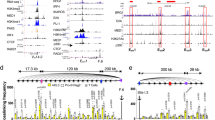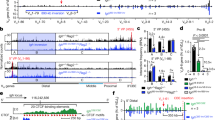Abstract
The tissue- and stage-specific assembly of antigen receptor genes by V(D)J recombination is regulated by changes in the chromatin accessibility of target gene segments. This dynamic remodeling process is coordinated by cis-acting promoters and enhancers, which function as accessibility control elements. The basic epigenetic mechanisms that activate or repress chromatin accessibility to V(D)J recombinase remain unclear. We now demonstrate that a histone methyltransferase overrides accessibility control element function and cripples V(D)J recombination of chromosomal gene segments. The recruited histone methyltransferase induces extensive revisions in the local chromatin environment, including altered histone modifications and de novo methylation of DNA. These findings indicate a key function for histone methyltransferases in the tissue- and stage-specific suppression of antigen receptor gene assembly during lymphocyte development.
This is a preview of subscription content, access via your institution
Access options
Subscribe to this journal
Receive 12 print issues and online access
$209.00 per year
only $17.42 per issue
Buy this article
- Purchase on Springer Link
- Instant access to full article PDF
Prices may be subject to local taxes which are calculated during checkout





Similar content being viewed by others
References
Emerson, B.M. Specificity of gene regulation. Cell 109, 267–270 (2002).
Agalioti, T. et al. Ordered recruitment of chromatin modifying and general transcription factors to the IFN-β promoter. Cell 103, 667–678 (2000).
Peterson, C.L. & Workman, J.L. Promoter targeting and chromatin remodeling by the SWI/SNF complex. Curr. Opin. Genet. Dev. 10, 187–192 (2000).
Cosma, M.P. Ordered recruitment: gene-specific mechanism of transcription activation. Mol. Cell 10, 227–236 (2002).
Hatzis, P. & Talianidis, I. Dynamics of enhancer-promoter communication during differentiation-induced gene activation. Mol. Cell 10, 1467–1477 (2002).
Jenuwein, T. & Allis, C.D. Translating the histone code. Science 293, 1074–1080 (2001).
Smale, S.T. The establishment and maintenance of lymphocyte identity through gene silencing. Nat. Immunol. 4, 607–615 (2003).
Strahl, B.D. & Allis, C.D. The language of covalent histone modifications. Nature 403, 41–45 (2000).
Peters, A.H. et al. Loss of the Suv39h histone methyltransferases impairs mammalian heterochromatin and genome stability. Cell 107, 323–337 (2001).
Tamaru, H. & Selker, E.U. A histone H3 methyltransferase controls DNA methylation in Neurospora crassa. Nature 414, 277–283 (2001).
Schatz, D.G., Oettinger, M.A. & Baltimore, D. The V(D)J recombination activating gene, RAG-1. Cell 59, 1035–1048 (1989).
Oettinger, M.A., Schatz, D.G., Gorka, C. & Baltimore, D. RAG-1 and RAG-2, adjacent genes that synergistically activate V(D)J recombination. Science 248, 1517–1523 (1990).
Mostoslavsky, R., Alt, F.W. & Bassing, C.H. Chromatin dynamics and locus accessibility in the immune system. Nat. Immunol. 4, 603–606 (2003).
Krangel, M.S. Gene segment selection in V(D)J recombination: accessibility and beyond. Nat. Immunol. 4, 624–630 (2003).
Hesslein, D.G. & Schatz, D.G. Factors and forces controlling V(D)J recombination. Adv. Immunol. 78, 169–232 (2001).
Oltz, E.M. Regulation of antigen receptor gene assembly in lymphocytes. Immunol. Res. 23, 121–133 (2001).
Shinkai, Y. et al. Restoration of T cell development in RAG-2-deficient mice by functional TCR transgenes. Science 259, 822–825 (1993).
Stanhope-Baker, P., Hudson, K.M., Shaffer, A.L., Constantinescu, A. & Schlissel, M.S. Cell type-specific chromatin structure determines the targeting of V(D)J recombinase activity in vitro. Cell 85, 887–897 (1996).
Mathieu, N., Hempel, W.M., Spicuglia, S., Verthuy, C. & Ferrier, P. Chromatin remodeling by the T cell receptor (TCR)-β gene enhancer during early T cell development: Implications for the control of TCR-β locus recombination. J. Exp. Med. 192, 625–636 (2000).
Mostoslavsky, R. et al. Kappa chain monoallelic demethylation and the establishment of allelic exclusion. Genes Dev. 12, 1801–1811 (1998).
Demengeot, J., Oltz, E.M. & Alt, F.W. Promotion of V(D)J recombinational accessibility by the intronic E κ element: role of the κB motif. Int. Immunol. 7, 1995–2003 (1995).
Whitehurst, C.E., Schlissel, M.S. & Chen, J. Deletion of germline promoter PDβ1 from the TCRβ locus causes hypermethylation that impairs Dβ1 recombination by multiple mechanisms. Immunity 13, 703–714 (2000).
Morshead, K.B., Ciccone, D.N., Taverna, S.D., Allis, C.D. & Oettinger, M.A. Antigen receptor loci poised for V(D)J rearrangement are broadly associated with BRG1 and flanked by peaks of histone H3 dimethylated at lysine 4. Proc. Natl. Acad. Sci. USA 100, 11577–11582 (2003).
McMurry, M.T. & Krangel, M.S. A role for histone acetylation in the developmental regulation of VDJ recombination. Science 287, 495–498 (2000).
Sikes, M.L., Meade, A., Tripathi, R., Krangel, M.S. & Oltz, E.M. Regulation of V(D)J recombination: a dominant role for promoter positioning in gene segment accessibility. Proc. Natl. Acad. Sci. USA 99, 12309–12314 (2002).
Tripathi, R., Jackson, A. & Krangel, M.S. A change in the structure of Vβ chromatin associated with TCRβ allelic exclusion. J. Immunol. 168, 2316–2324 (2002).
Spicuglia, S. et al. Promoter activation by enhancer-dependent and -independent loading of activator and coactivator complexes. Mol. Cell 10, 1479–1487 (2002).
Casellas, R. et al. OcaB is required for normal transcription and V(D)J recombination of a subset of immunoglobulin κ genes. Cell 110, 575–585 (2002).
Hesslein, D.G. et al. Pax5 is required for recombination of transcribed, acetylated, 5′ IgH V gene segments. Genes Dev. 17, 37–42 (2003).
Ferrier, P. et al. Separate elements control DJ and VDJ rearrangement in a transgenic recombination substrate. EMBO J. 9, 117–125 (1990).
Sikes, M.L., Suarez, C.C. & Oltz, E.M. Regulation of V(D)J recombination by transcriptional promoters. Mol. Cell. Biol. 19, 2773–2781 (1999).
Tachibana, M. et al. G9a histone methyltransferase plays a dominant role in euchromatic histone H3 lysine 9 methylation and is essential for early embryogenesis. Genes Dev. 16, 1779–1791 (2002).
Agalioti, T., Chen, G. & Thanos, D. Deciphering the transcriptional histone acetylation code for a human gene. Cell 111, 381–392 (2002).
Grewal, S.I. & Moazed, D. Heterochromatin and epigenetic control of gene expression. Science 301, 798–802 (2003).
Shi, Y. et al. Coordinated histone modifications mediated by a CtBP co-repressor complex. Nature 422, 735–738 (2003).
Ogawa, H., Ishiguro, K., Gaubatz, S., Livingston, D.M. & Nakatani, Y. A complex with chromatin modifiers that occupies E2F- and Myc-responsive genes in G0 cells. Science 296, 1132–1136 (2002).
Ayyanathan, K. et al. Regulated recruitment of HP1 to a euchromatic gene induces mitotically heritable, epigenetic gene silencing: a mammalian cell culture model of gene variegation. Genes Dev. 17, 1855–1869 (2003).
Snowden, A.W., Gregory, P.D., Case, C.C. & Pabo, C.O. Gene-specific targeting of H3K9 methylation is sufficient for initiating repression in vivo. Curr. Biol. 12, 2159–2166 (2002).
Chowdhury, D. & Sen, R. Transient IL-7/IL-7R signaling provides a mechanism for feedback inhibition of immunoglobulin heavy chain gene rearrangements. Immunity 18, 229–241 (2003).
Litt, M.D., Simpson, M., Gaszner, M., Allis, C.D. & Felsenfeld, G. Correlation between histone lysine methylation and developmental changes at the chicken β-globin locus. Science 293, 2453–2455 (2001).
Cherry, S.R. & Baltimore, D. Chromatin remodeling directly activates V(D)J recombination. Proc. Natl. Acad. Sci. USA 96, 10788–10793 (1999).
Bird, A. DNA methylation patterns and epigenetic memory. Genes Dev. 16, 6–21 (2002).
Zeschnigk, M. et al. Imprinted segments in the human genome: different DNA methylation patterns in the Prader-Willi/Angelman syndrome region as determined by the genomic sequencing method. Hum. Mol. Genet. 6, 387–395 (1997).
Nan, X. et al. Transcriptional repression by the methyl-CpG-binding protein MeCP2 involves a histone deacetylase complex. Nature 393, 386–389 (1998).
Jones, P.L. et al. Methylated DNA and MeCP2 recruit histone deacetylase to repress transcription. Nat. Genet. 19, 187–191 (1998).
Cedar, H. & Bergman, Y. Developmental regulation of immune system gene rearrangement. Curr. Opin. Immunol. 11, 64–69 (1999).
Bannister, A.J. et al. Selective recognition of methylated lysine 9 on histone H3 by the HP1 chromo domain. Nature 410, 120–124 (2001).
Lachner, M., O'Carroll, D., Rea, S., Mechtler, K. & Jenuwein, T. Methylation of histone H3 lysine 9 creates a binding site for HP1 proteins. Nature 410, 116–120 (2001).
Lehnertz, B. et al. Suv39h-mediated histone H3 lysine 9 methylation directs DNA methylation to major satellite repeats at pericentric heterochromatin. Curr. Biol. 13, 1192–2000 (2003).
Fuks, F., Hurd, P.J., Deplus, R. & Kouzarides, T. The DNA methyltransferases associate with HP1 and the SUV39H1 histone methyltransferase. Nucleic Acids Res. 31, 2305–2312 (2003).
Acknowledgements
We thank M. Sikes (North Carolina State University), K. Oestreich and H. Vekony (Vanderbilt University) for pilot studies during the initial stages of this project. We also thank D. Ballard (Vanderbilt University) for comments. Supported by the National Institutes of Health (P01 HL68744 and AI49934, E.M.O.; AI49934 and GM41052, M.S.K.), the Ministry of Education, Science, Sports, Culture, and Technology of Japan (Y.S.) and a Cancer Center Support Grant (P30 CA68485, Vanderbilt-Ingram Cancer Center).
Author information
Authors and Affiliations
Corresponding author
Ethics declarations
Competing interests
The authors declare no competing financial interests.
Supplementary information
Rights and permissions
About this article
Cite this article
Osipovich, O., Milley, R., Meade, A. et al. Targeted inhibition of V(D)J recombination by a histone methyltransferase. Nat Immunol 5, 309–316 (2004). https://doi.org/10.1038/ni1042
Received:
Accepted:
Published:
Issue Date:
DOI: https://doi.org/10.1038/ni1042
This article is cited by
-
Establishment of H3K9-methylated heterochromatin and its functions in tissue differentiation and maintenance
Nature Reviews Molecular Cell Biology (2022)
-
Monitoring the crosstalk between methylation and phosphorylation on histone peptides with host-assisted capillary electrophoresis
Analytical and Bioanalytical Chemistry (2020)
-
Localized epigenetic changes induced by DH recombination restricts recombinase to DJH junctions
Nature Immunology (2012)
-
Determinants of public T cell responses
Cell Research (2012)



